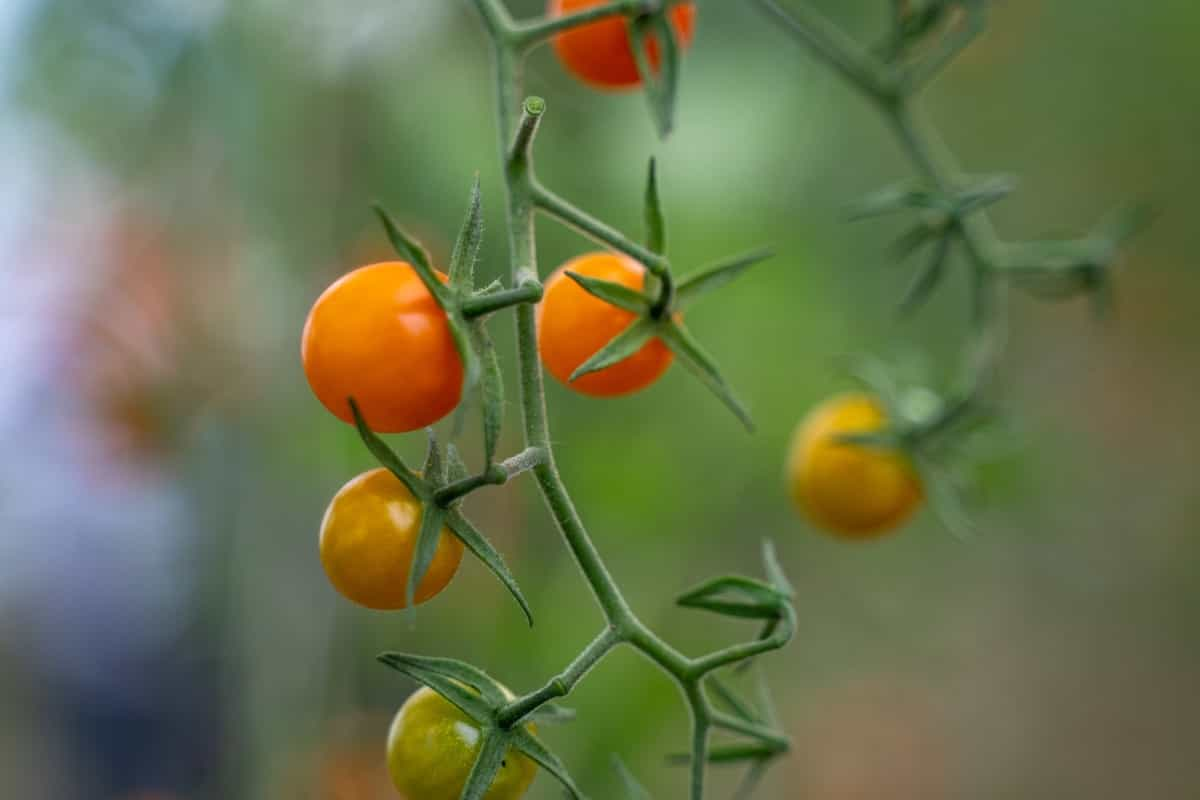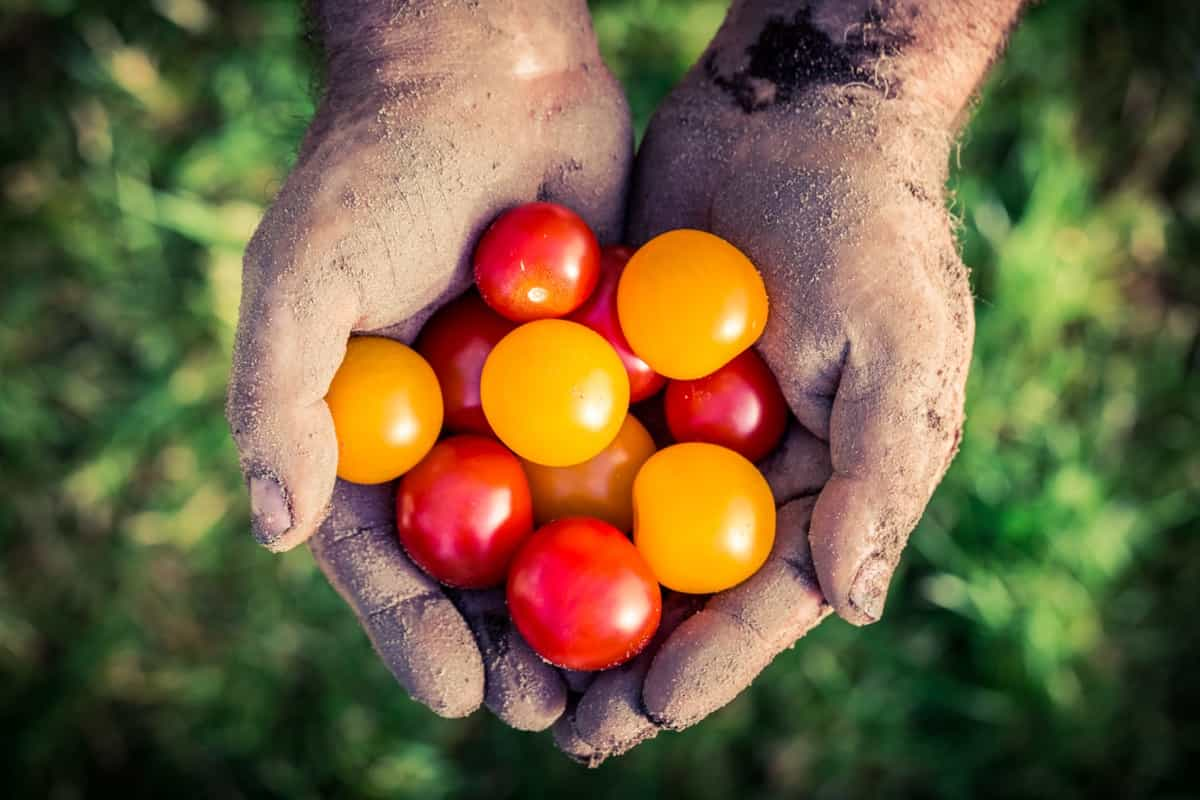Tomatoes
Sungold tomatoes are a popular variety known for their sweet and tangy flavor. If you’re interested in growing and caring for these delicious tomatoes, here’s a step-by-step guide to help you from seed to harvest.

How to Grow and Care for Sungold Tomatoes
About Sungold Tomato Variety
- Weight: The Sungold tomato variety is known for its small and lightweight nature. Each tomato typically weighs around 15-20 grams.
- Taste: These tomatoes have a sweet and tropical flavor, often described as a perfect balance between sweetness and acidity.
- Size: Sungold tomatoes are relatively small in size, measuring about 1 inch in diameter. While they may be small, they pack a punch in terms of flavor and nutritional value.
- Color: When fully ripened, these tomatoes develop an intense golden-orange hue that stands out among other varieties.
- Texture: Sungold tomatoes have a smooth and firm texture, making them pleasant to bite into.
- Nutritional Value: These tomatoes are rich in vitamins A and C and antioxidants. Additionally, they contain lycopene, a powerful antioxidant known for its potential health benefits.
- Sungold tomatoes in containers: This variety is great for a container. It should be fairly large, at least 24-48 inches deep, and 18-36 inches in diameter for most varieties.
- How tall do Sungold tomatoes grow?: 6-10 feet
Choosing the Right Location With Good Sunlight for Sungold Tomatoes
Sungold tomatoes require at least six to eight hours of direct sunlight daily. Look for an area in your garden that receives ample sunlight throughout the day, preferably facing south or west. Avoid planting them in shaded or heavily shaded areas, which can hinder their growth and reduce fruit production.
Preparing the Soil for Sungold Tomatoes
- Before preparing the soil, remove any weeds, rocks, or debris from the designated area.
- Use a tiller or else garden fork to loosen the soil to 12 inches deep. This will help the Sungold tomatoes’ roots penetrate easily and allow for proper drainage.
- Sungold tomatoes prefer slightly acidic soil with a pH between 6.0 and 6.8. If the soil is too alkaline, use sulfur or peat moss to lower the pH. Conversely, add lime to raise the pH if the soil is too acidic.
- Incorporate a 2 to 3-inch layer of organic matter such as compost, well-aged manure, or leaf mold into the soil to improve its fertility and structure.
- After preparing the soil, apply a layer of organic mulch around the Sungold tomato plants. Straw, wood chips, or shredded leaves are suitable options for mulch.
Planting and How to Grow Sungold Tomatoes
Start Sungold tomatoes from seeds indoors six to eight weeks in advance of the last frost date in your area. Seeds should be planted in small containers filled with seed-starting mix and kept in a warm, bright place. The seedlings can be transplanted outside once they reach about 2 inches in height. You can transplant your Sungold tomato seedlings when the soil temperature reaches around 15°C after the danger of frost has passed.
Plants should be spaced about 24 to 36 inches apart, and a hole large enough to accommodate their root balls should be dug. Carefully remove your Sungold tomato seedlings from their containers and place them in the holes, taking care not to damage the roots. Place the plants in the holes and backfill them with soil, firming them gently around their bases.
Watering Requirements for Sungold Tomatoes
Sungold tomatoes require regular watering to maintain consistent soil moisture. Water the plants deeply once or twice a week, based on the weather conditions. As a thumb rule, provide 1-1 1/2 inches of water per week. More frequent watering may be necessary during hot and dry periods to prevent the soil from drying completely. However, be careful not to over-water, as it can lead to waterlogged soil and root problems.
Fertilizing Sungold Tomatoes
Generally, work 1000-1500 grams (10-10-10 NPK) of a complete fertilizer per 100 square feet into garden soil as soon as possible after a soil test. Using a high-nitrogen fertilizer is not recommended, as it can result in lush foliage but delayed flowering and fruiting. Strong roots are developed when plants are given a head start with diluted liquid fertilizer high in phosphorus. Regular fertilization is recommended for container-grown Sungold plants. Apply a water-soluble fertilizer at half strength to tomato plants to ensure a constant supply of nutrients.
In case you missed it: When to Transplant Tomato Seedlings: 10 Things to Check First

Pruning Techniques of Sungold Tomatoes
Regular pruning helps Sungold tomatoes produce more fruit than foliage. Do you remove side shoots from Sungold tomatoes? Remove small stems or side shoots near a leaf cluster with garden snips from the main stem. These side shoots tend to produce foliage but not fruit. The plant can concentrate its energy on its fruit-bearing stems if you remove them. If any stems are touching the ground, prune them to prevent disease.
Supporting the Sungold Tomato Plants
To ensure the success of your Sungold Tomato plants, it is important to provide them with proper support. Several methods can be used to support Sungold Tomato plants. One common technique is the use of tomato cages. These wire or wooden structures are placed around the young plants, providing a framework for the branches’ growth. Another method of supporting Sungold Tomato plants is the use of stakes.
The tomato plant’s main stem should be tied to the stake using soft garden twine or plant ties. Stakes should be driven into the ground at least 6 to 8 inches deep to ensure stability. Trellising is another option for supporting Sungold Tomato plants. Trellises are vertical structures made of wood, metal, or plastic, with horizontal supports for growing plants. This method is particularly useful for gardeners with limited space, as it allows the plants to grow upwards rather than spreading outwards.
Pest and Disease Management in Sungold Tomatoes
Aphids: Natural predators like ladybugs and lacewings can be introduced to the garden to control aphids. Alternatively, applying insecticidal soap or neem oil can help suppress aphid populations.
Whiteflies: Regularly spraying plants with a strong jet of water can also dislodge whiteflies. Neem oil or insecticidal soap application is recommended in severe cases.
Tomato hornworms: Handpicking and removing hornworms from plants is an effective control method for smaller infestations. Bacillus thuringiensis (Bt), a naturally occurring bacteria, can be applied as a biological control agent to target hornworms.
Early Blight: To prevent early blight, practice crop rotation and avoid overhead watering. Remove and destroy infected plant material, and apply fungicides as a preventive measure.
Late Blight: To manage late blight, remove and destroy infected plants immediately. Fungicides containing copper can be applied as a preventive measure.
Fusarium wilt: To prevent fusarium wilt, use disease-resistant tomato varieties and practice crop rotation. Avoid overwatering and implement proper sanitation practices to reduce the spread of the disease.
Harvesting and Storage of Sungold Tomatoes
Sungold tomatoes are ready to be harvested when they reach their full color, a vibrant orange. Gently hold the tomato and twist it until it comes off the vine. It is important not to pull too hard, as this can damage the plant. Alternatively, you can use a pair of garden shears to cut the tomato from the stem, leaving a short stem attached.
In case you missed it: 10 Best Sauce Tomato Varieties You Should Grow in Your Garden

After harvesting, sort through the harvested tomatoes, discarding any overripe, bruised, or with signs of disease. Separate the tomatoes by size, as this will help with storage and prevent larger tomatoes from crushing smaller ones. Sungold tomatoes are best stored at room temperature, away from direct sunlight.
Conclusion
Sungold tomatoes can be successfully grown from seed to harvest if you follow these steps. Enjoy the process and the rewarding experience of savoring these delicious Sungold tomatoes in your garden.
- Feed Your Flock for Less: Top 10 Tips to Save on Chicken Feed
- Ultimate Guide to Ossabaw Island Hog: Breeding, Raising, Diet, and Care
- Hatching Answers: The Top 10 Reasons Your Chickens Aren’t Laying Eggs
- Eggs and Economics: Breaking Down the Cost of Raising Backyard Chickens
- Defend Your Greens: Proven Methods to Keep Iguanas Out of Your Garden
- Ultimate Guide to Cinnamon Queen Chicken: A Comprehensive Guide for Beginners
- Ultimate Guide to California Tan Chicken: Breeding, Raising, Diet, Egg-Production and Care
- Ultimate Guide to Marsh Daisy Chicken: Breeding, Raising, Diet, and Care
- 10 Types of Chicken Farming Businesses You Can Start for Profits